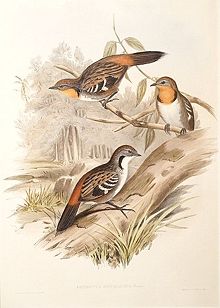Orthonyx temminckii
| Australian logrunner | |
|---|---|
 |
|
| Scientific classification | |
| Kingdom: | Animalia |
| Phylum: | Chordata |
| Class: | Aves |
| Order: | Passeriformes |
| Family: | Orthonychidae |
| Genus: | Orthonyx |
| Species: | O. temminckii |
| Binomial name | |
|
Orthonyx temminckii Ranzani, 1822 |
|
The Australian logrunner (Orthonyx temminckii) is a species of bird that is endemic to eastern Australia where it uses unique foraging techniques and adaptations to search for its food on the floors of temperate, subtropical, or tropical moist lowland forests in south-eastern Australia. Until 2002, it was widely considered to be conspecific with the New Guinea logrunner, but studies showed the two differ significantly, both genetically and vocally.
It known by a number of common names including spine-tailed logrunner, spine-tail, logrunner, scrub quail and chowcilla.
The Australian logrunner is a Passeriform in the family Orthonychidae. It is one of only three species within the single Orthonyx genus; the other two are the chowcilla (Orthonyx spaldingii) from northern Queensland and the New Guinean logrunner (Orthonyx novaeguineae) from Papua New Guinea.
Logrunners as a group are characterised within their group by their distinctive tail feathers where the rachis (or central shafts) of the tail feathers protrude and are stiffened. The broad tail of the bird is less than four inches (10 cm) in length and the strong protruding rachis at the ends of the tail feathers are almost void of the usual barbs, giving the feather the appearance of spines. This appearance gives rise to some of the common names for the bird such as spine-tail or spine-tailed logrunner.
There appears to be some debate about the number of tail feathers possessed by the Australian logrunner. For example, some references state that the logrunner only has 10 tail feathers whilst other references describe the bird as having 12 tail feathers. Most birds are described as having 12 tail feathers but there are notable exceptions to this.
The logrunner is not unique in having atypical tail feather structures. Other birds, such as the Greater Melampitta (Melampitta gigantea), also have spiny and stiffened tail feathers, but not to the same extent as the logrunner. Birds such as creepers, woodpeckers, swifts and penguins are also known to use their modified tail feathers as braces and supports.
...
Wikipedia

